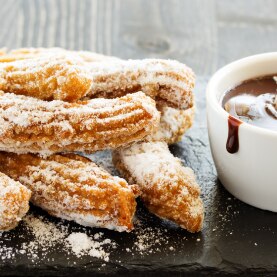Chocolate in Europe
In the 17th century, Europeans prepared, flavoured and spiced their drinking chocolate according to their personal whims and preferences. Chocolate pots, molinets for frothing the mixture, trembleuse cups (spill-proof with deep saucers), and even cups with moustache guards, all contributed to perfecting the art of preparing and drinking chocolate.
A precious drink
When drinking chocolate arrived in Europe in the mid-16th century, it was prepared in the same way the Aztecs prepared it and was not immediately popular. It had to be adapted to European tastes, by replacing the chilli with sugar, for it to become universally adopted. A precious, expensive drink, enjoyed by the privileged classes, chocolate preparation and drinking went on to become an art and lead to the creation of a range of specific utensils.
European tastes
The drink’s three basic ingredients were grated cocoa paste, water and sugar, mixed together and usually consumed hot. However, depending on the countries and various medical prescriptions, numerous nuances were added to the basic mixture. In Italy, for example, it was flavoured with lemon zest, vanilla, jasmine, ambergris (used in medicines, perfume and as a spice) or cinnamon. The British were particularly daring, sometimes replacing the water with wine or milk, or even adding egg yolks. Doctors would prescribe chocolate infused with cloves for stomach aches or adding amber to counteract fatigue. If the cocoa was too rich, its negative effects could be counterbalanced by vanilla or cinnamon. Innumerable combinations were created to cater for different tastes and preferences.
New equipment
To prepare drinking chocolate properly, it had to be made in a chocolate pot, which was similar to a coffee pot in shape, with a molinet, to froth up the mixture. The chocolate would be blended with water to release the aromas and obtain a light, frothy liquid. The first chocolate pots were simple in their design and use of materials, but they gradually became more refined, and were soon made of porcelain and silver. In France, they were even called commodités de conversation, as they would create a convivial atmosphere in parlours when drinking chocolate was offered on social occasions.
For this drink to be better appreciated, a special spill-proof cup was developed, known as a trembleuse. The saucer had a hollow section and a little porcelain ridge to stabilise the cup. This ensured that not a drop of the precious beverage was lost and that ladies’ dresses were not at risk. In Spain, they were known as mancerina cups, after their inventor, the Marquis of Mancera, who served as the Viceroy of Peru in the 17th century.
A short-lived fashion
In the 19th century, the British invented the moustache cup to prevent the frothy chocolate from soiling gentlemen’s whiskers. The fashion did not last very long, except in the United States, where it apparently continued until the end of the century.
KHODOROWSKY, Katherine et ROBERT, Hervé, 2009. Tout sur le chocolat. Paris : Odile Jacob.
DE CONTENSON, Elisabeth, 2010. Le chocolat et son histoire. Paris : Archives & Cultures.
AYRAL, Dominique, 2000. Passion chocolat. Luxembourg : Éditions Le Phare - Hachette.







